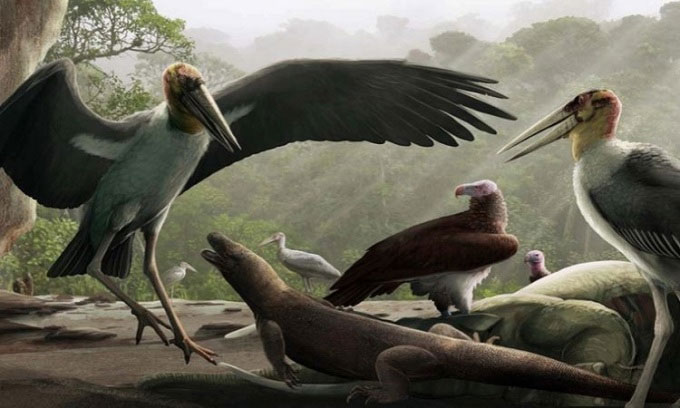Archaeologists find fossils of ancient giant storks taller than humans

Restoration image of the giant stork on Flores Island.
In ancient Flores, an island in eastern Indonesia, dwarves (Homo floresiensis) once lived with giant storks. With a height of more than 1.5 meters, the Stone Age stork Leptoptilos robustus was much larger than the 0.9 meter tall H. floresiensis, who lived more than 60,000 years ago. Previously, paleontologists thought that L. robustus was a flightless bird adapted to an isolated ecosystem on the island. But new analysis of the wing bone fossils, published July 13 in the journal Royal Society Open Science, has changed their minds. Despite its large size, the 3.7 meter wingspan most likely allowed the ancient storks to fly high.
The new discovery prompted paleontologists to reconsider the body composition and behavior of L. robustus. Instead of hunting small prey, their study suggests they were likely scavengers like many other prehistoric flying storks, similar to the sub-Saharan marabou storks today. Flores's preference for carcasses may even explain why they became extinct.
The team was able to create a new image of the giant stork Flores using 21 bones, including a wing bone found in the Liang Bua cave, where they avoid heat and drink water. But predators can take advantage of the opportunity to catch prey easily. The carcass of an animal killed by a Komodo dragon or H. floresiensis can attract storks to eat the leftovers. They can then die in the cave and be buried there, becoming fossils after tens of thousands of years.
The first bones of L. robustus were discovered in 2004, but it took years for experts to collect and classify more fossils coming from this species. New research by Meijer and colleagues helps create a more complete picture of the animal. If Flores storks can't fly, their wing bones will be smaller and there are signs that the part is no longer used for flight. When the wing bones of Flores's stork were identified in the Liang Bua cave collection, Meijer noticed that they looked like wing bones used for flight. The discovery made the team change their mind about giant birds.
- Detection of giant penguin fossils in New Zealand
- Giant fossils and the fear of prehistoric creatures
- Detecting the last ancestral fossils of humans and monkeys
- Fossils discovered 300,000 years old
- Find ancient giant footprints in Africa
- Discover an ancient mouse that is as big as a dog
- Find out the ancient giant panda DNA
- Detecting ancient whale fossils with strange shapes
- Find the mystery that makes the world's largest shark disappear
- Close up of fossils of crocodiles, elephants, giant prehistoric birds
- South Korea 'revived' extinct birds for 40 years
- Decoding giant bones in Italy
 Discovered an ancient centipede fossil 99 million years old
Discovered an ancient centipede fossil 99 million years old Discovered bat-like dinosaurs in China
Discovered bat-like dinosaurs in China Discovered a 200-year-old bronze cannon of the coast
Discovered a 200-year-old bronze cannon of the coast Discover 305 million-year-old spider fossils
Discover 305 million-year-old spider fossils